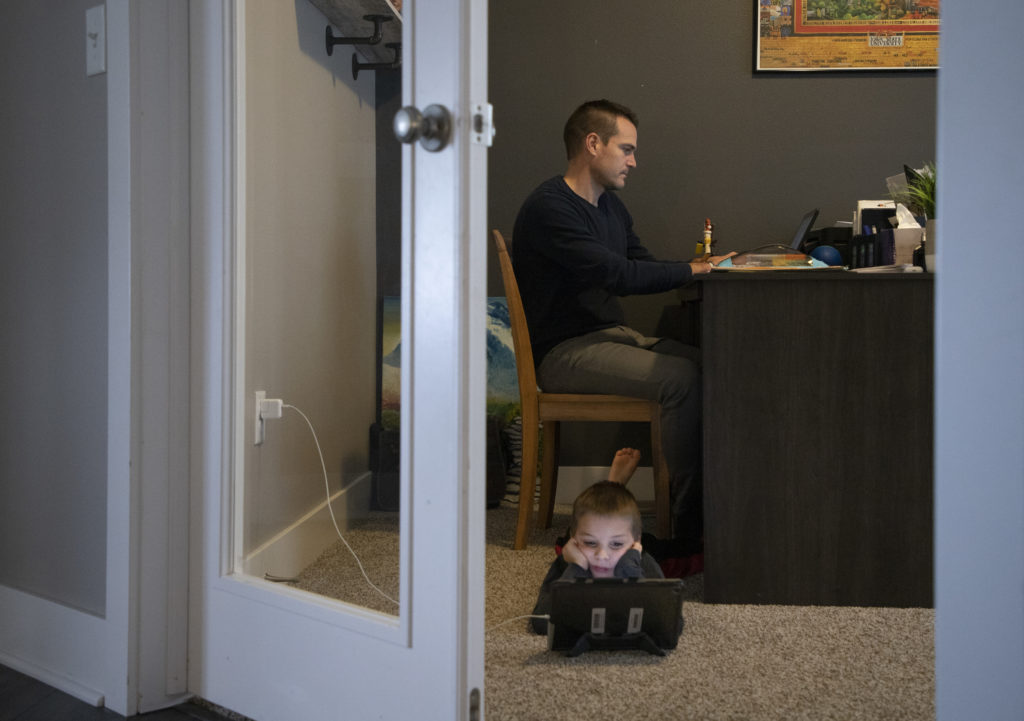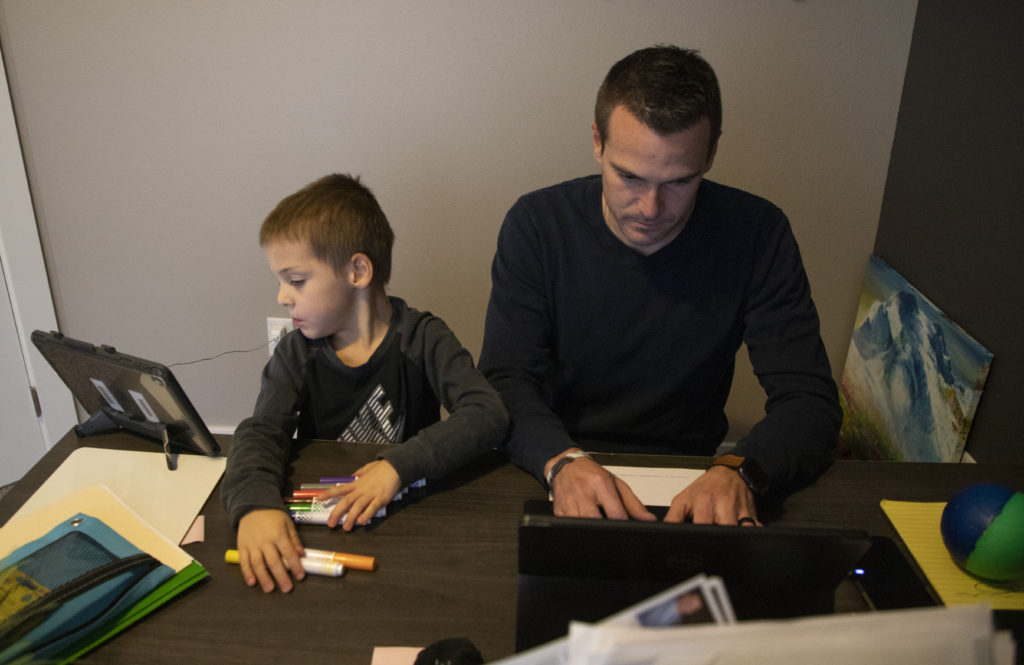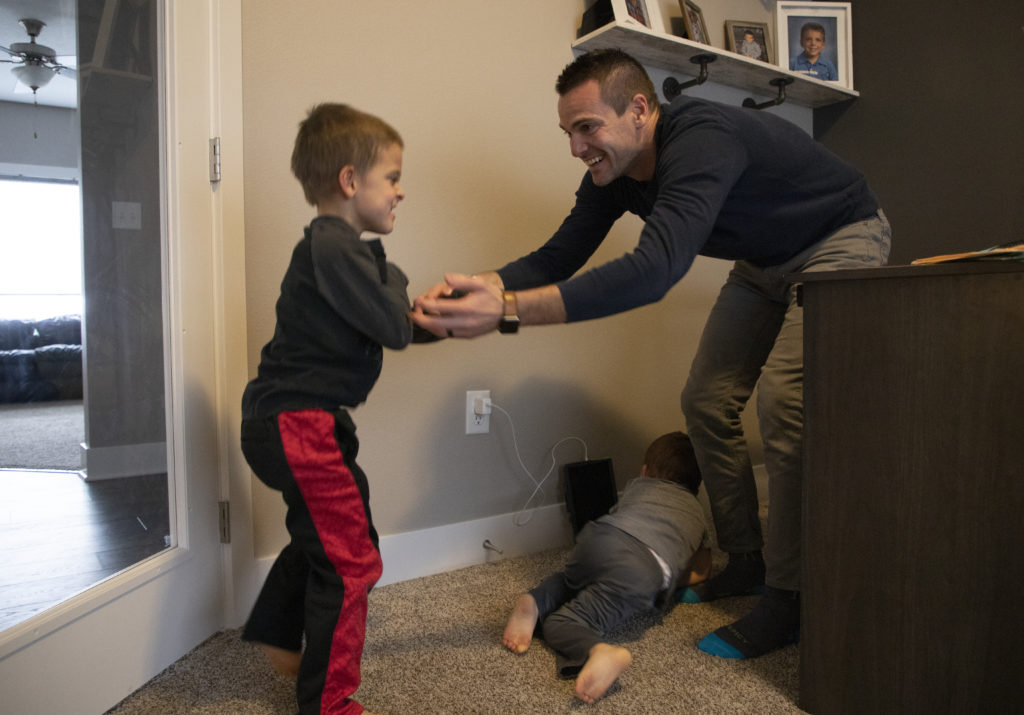Photos and story by Emily Blobaum

When you think about the topic of paternity leave, your mind probably doesn’t immediately go to Disney Pixar movies. Or maybe it does.
When I asked Ben Keenan, an HR consultant at Principal Financial Group, why he took paternity leave, he asked me if I had seen the Pixar movie “Inside Out.” Having watched it before, I immediately knew where he was going.
The main premise of the movie is about emotions, but of particular importance are core memories, which are key events and milestones like taking your first step or scoring your first goal in a hockey game.
“There are these game-changing moments in your life, and welcoming a new child into the world is one of them. I don’t want to miss out on those moments. It’s important to be there for them, for your child and your partner,” Keenan said.
Keenan is a father of four — two twin boys who are almost 6, a 3 1/2-year-old son and a 10-week-old daughter.
Under Principal Financial Group’s parental leave policy, non-birthing parents are able to take four weeks of paid leave for bonding with a new child within 12 months of their birth or adoption and are able to separate it out into chunks.
After conversing with his wife, Kenzie, Keenan took only a week of paternity leave immediately after his daughter was born.
“Guys can’t do a lot to help at the beginning, at least when moms are trying to breastfeed. … That’s why I don’t use [all of my paternity leave] right away and wait until some of the help [i.e., grandparents] is gone and then try to be more helpful later on,” he said.
Keenan has had prior experience in navigating paternity leave. His twin boys, Brooks and Beckett, were born unexpectedly premature at 28 weeks. He took his laptop to the hospital and worked from there, opting to take his leave — back then it was two weeks — when they were home and would need to be bottle-fed every two hours. With his other son, Brendon, Principal’s policy had recently changed to four weeks. He opted to take two weeks right away and save the other two for later on.
Now in 2020, he’s in a unique position where he’s still able to spend time with his family, even while he’s not on paternity leave, thanks to the flexibility that comes with working from home.
“I absolutely love [working from home]. I didn’t at first because of the huge adjustment it was for all of us kids and parents. … I wasn’t sure I was going to be able to stick it out. But now, kind of like the advantage of parental leave, you get to be a part of so many more moments during the day. Even the frustrating ones are great ones to be a part of because they’re ones that I wasn’t necessarily seeing before. That’s just been really, really fun.”
Favorite moments include teaching his kids how to ride a bike, participating in indoor recess — a new activity, after someone tested positive for COVID at the twins’ elementary school, sending them home to learn virtually — wrestling with his kids during breaks in between meetings, and being part of potty training.
Another big reason why Keenan has taken advantage of paternity leave is for Kenzie, who spent 10 years as an elementary school teacher and recently became a real estate agent.
“Ultimately it’s about being involved with my children and helping to take care of them and show them the appropriate framework for a partnership. To take time away and be actually physically present and be a part of those conversations will help illustrate the way I want them to be treated and treat others.”

Earlier this year, Alexis Ohanian, founder of Reddit and husband to Serena Williams, argued in an op-ed that the fight for paternity leave is a feminist one and it’s up to fathers to normalize taking advantage of it.
In it, he responded to a 2019 incident where Melanie Whelan, then CEO of SoulCycle, allegedly told a male employee who was planning on taking paternity leave that “paternity leave is for pussies.”
“The implication that paternity leave is unimportant sets a dangerous precedent, one that suggests fathers are not an integral part of the child care unit, and perpetuates the antiquated belief that mothers alone should be the primary caregivers,” he wrote.
Harris Federman, a data and operations research scientist at Principal Financial Group, said: “I don’t want to get overly political, but there’s an issue with having two-week paternity leave and three-month maternity leave. That issue is whether, intentionally or not, you’re disadvantaging the females in career progression.”
Numerous studies have shown that paternity leave increases male participation in the home and female participation in the workforce. It helps shape parenting habits from day one and breaks down stereotypical gender roles.
“Child rearing is not just a mother’s job,” Keenan said.

When Federman’s daughter was born in 2018, he was working at General Mills as a plant engineer. At the time, General Mills’ paternal leave policy was two weeks, but it was in the process of expanding its benefit to 12 weeks of paid leave for fathers, adoptive parents and partners. Additionally, the policy included up to 14 weeks of unpaid parental bonding leave to align with the same 26 available weeks that birth mothers are eligible for.
Federman welcomed the change, but he also knew that his daughter would be born before the new policy was implemented. Coordinating two parental leave policies to line up with an already-secured day care spot would take some finessing.
He hoped to be able to work it out to take his two weeks of leave right when his daughter was born and then split the remaining 10 weeks of FMLA time after his wife’s six-month maternity leave was up at Dorsey & Whitney.
But due to a miscommunication, the FMLA didn’t work out the way he planned, but was able to switch his schedule to work the second shift for six weeks to be able to watch his daughter during the day.
For reasons unrelated, Federman left General Mills to work at Principal in March 2019 and admits that it was hard to leave the parental leave benefit behind.
“Honestly, it was probably the biggest drawback to going to Principal because I had already known that General Mills had changed their policy by that point to six months so I left that time on the table.”
Federman and his wife welcomed another child, a son, in October. Like Keenan, he’s working from home and hasn’t taken his four weeks of paternity leave. Instead, he took some vacation time around his son’s birth and is waiting until his wife goes back to work to take his paternity leave.
“It sets a good stage for a relationship with your children. Being super involved, I feel like taking that time allows my wife to focus on her career too and it does create a sense of balance in the household, which is fantastic.”
As much as we as a society try to dismantle the stereotypical gender roles of men being the providers and women being the caregivers for the family, stigmas around fathers taking time off from work to focus on their families still exist, whether internally or externally.
A 2015 Department of Labor survey found that 9 out of 10 fathers in the U.S. take some time off for the birth or adoption of a child, but 70% of them take 10 days of leave or less.
“There is this internal obligation to continue to ensure that our family has enough, whether that’s medical coverage or pay compensation, that we have enough for what we need during the week,” Keenan said. “A part of me says that I have to be contributing to work so much per week to feel like I’m meeting that commitment, but that internal feeling has changed pretty drastically in the last six years.”

Jay Teeter has been a stay-at-home dad for eight years. Before that, he was a high school science teacher in Wichita, Kan. His wife, Tanya, works as the vice president of labor relations at Cargill.
They, along with their two sons, decided to move to the Des Moines area eight years ago to be closer to family when Tanya’s job allowed her to work remotely.
They made the move in the middle of the school year, so it didn’t make sense for Teeter to find a new full-time job. Then they found out they were expecting their third son. Coupled with Tanya’s heavy travel schedule for work, they decided that it would be in their best interest for Teeter to stay at home to avoid having to hire a full-time nanny.
“Being a teacher, I already had been doing the stay-at-home thing during the summers. So it was fairly seamless to do that full time,” Teeter said.
He quickly settled into his new title, perusing the aisles at Costco, joining the after-school pickup line and even convincing Tanya that they needed a minivan — “they’re super functional.”
“I didn’t have any issue with the role. It was more of, I’d meet somebody new and they’d ask me what I do. At first it was a little bit of an ego check to say I’m actually just a stay-at-home dad.”
For the first few years, he said it felt isolating being one of the only or the only stay-at-home dad.
“The hardest part initially was not having the social circle. Being a teacher, I always had friend groups that were made up of the teachers I worked with. … [Being a stay-at-home dad], you’re sort of living in a mom’s world,” he said. “There wasn’t a network of similarly situated males that I was dealing with. And it’s not like I can’t interact with the moms, it’s just not quite the same thing.”
Now he’s found outlets through a group of guys he plays tennis with at Lifetime Fitness, golf buddies and by coaching his sons’ basketball team.
While his sons are all in school and have been for a while, he’s not in a rush to reenter the workforce. All of the responsibilities a teacher has outside the classroom with grading and planning seem daunting with all of the after-school activities his sons are active in, he said.
“Tanya has never pushed me to get back to working full time, and in some ways I think she kind of wishes I don’t because she doesn’t want any of the responsibilities like grocery shopping and cooking back on her,” Teeter said.
He’ll often joke and say that it never was a goal of his to only teach for 10 years and then be a stay-at-home dad after that.
“But I definitely don’t regret the way that it did turn out. It’s worked out well for our family as a whole, and I feel like my relationship with the boys has benefited from it.”
He also no longer puts the word “just” in front of “stay-at-home dad” when he meets someone new.
A whole other can of worms surrounding parental leave is availability.
While the Family and Medical Leave Act, which grants 12 weeks of job-protected unpaid leave for family and medical reasons, has been a saving grace for some, it still remains widely inaccessible.
The fine print of the FMLA reads that only those who have worked at a covered employer for at least a year and at least 1,250 hours are eligible. As a result, the National Partnership for Women and Families found that FMLA isn’t accessible for 61% of Iowans.
In a 2019 New America study, 87% of respondents said a reason men don’t take leave from work for caregiving is that they simply can’t afford it.
According to the Bureau of Labor Statistics, only 20% of workers in private industry have access to paid family leave.
The United States is the only country among 41 developed nations that doesn’t mandate any paid parental leave, according to data compiled by the Organization for Economic Cooperation and Development.
But, even if slowly, there is work being done.
This fall, Colorado voters approved a new paid family and medical leave law, joining eight other states and Washington, D.C., that have similar programs.
The Biden administration plans to push for paid family leave benefits. In an op-ed for Parents magazine, Vice President-elect Kamala Harris wrote, “We plan to provide people with up to 12 weeks of paid family and medical leave and paid sick days to make it easier for people to care for loved ones without facing lost income or being forced to choose between their jobs and their family.”
As of 2018, the 20 largest employers in the United States offer paid parental leave to at least some employees. IBM offers both salaried and hourly workers 20 weeks of paid leave for the birth parent and 12 weeks for the other parent. For both salaried and hourly workers, Walmart offers 16 weeks for the birth parent and six weeks for the other parent.
A 2017 Pew study found that while divided on who should cover the cost, most Americans support paid family and medical leave.

Coming out of the pandemic and months of working from home, companies will likely face pressure to create or improve already existing policies surrounding flexible work options.
Working from home has “made me reconsider employment moving forward and the flexibility of employers,” Keenan said. “If flexible work, at least on a part-time basis like one or two days a week, isn’t an option, I’m not sure I’d consider that as strongly as some of the other options out there, just because those moments and opportunities that I’ve seen, I want to continue to be around for.”
Note: For this particular piece, I talked to heterosexual couples. However, I would love to share stories of folks in same-sex relationships in future stories. If you are in a same-sex relationship and would like to share your own experience as a stay-at-home parent or someone who has taken parental leave, please email me at emilyblobaum@bpcdm.com.




2 Comments
doug woolf · January 18, 2021 at 2:52 pm
Enjoyed reading the article on the role of men in the “home” workplace. Gosh, I have/had been doing this work 40 years ago. All three children never knew when Dad did not coordinate the work @ home…
Seems like yesterday and you just hope the kids remember the contributions by Dad over the years.
Job Search Portal · February 17, 2022 at 7:45 pm
In Asian countries, and in many joint family systems, grandparents and other nonworking family members fulfill the need for childcare they take over the job of childcare when the mother is at work. This very important benefit (of readily available child support from the family members themselves) in joint families not only recognizes that the working mother is an important member of the family, but also provides her the necessary support to be able to perform her dual role efficiently. Stress loads can be quite high amongst working mothers and these may often reflect in their relationships at home. She is stressed to reach work on time, to send her child to school and to reach all the children’s deadlines on time including food and dress, and she is also pressed for time to look after her home simultaneously.
Comments are closed.